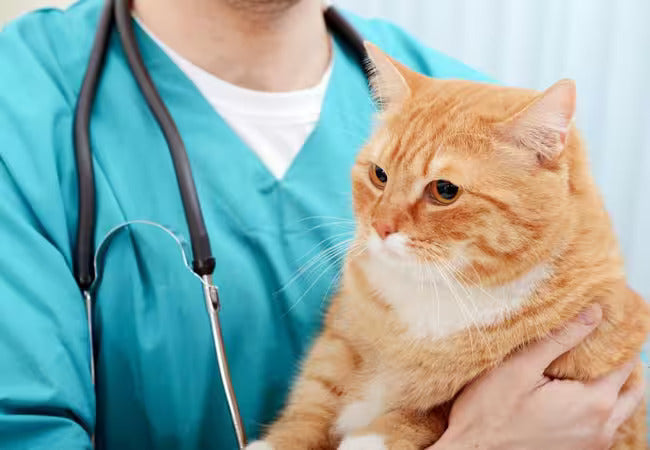Cat Fecal Tests 2025: Expert Veterinary Guide 🩺🐱

In this article
Cat Fecal Tests 2025: Expert Veterinary Guide 🩺🐱
By Dr. Duncan Houston BVSc
Hello! I’m Dr Duncan Houston BVSc, veterinarian and founder of Ask A Vet. Fecal testing is an unsung hero of preventive feline care—it helps detect internal parasites and infections early. In this detailed 2025 guide, we’ll explore testing methods, why they matter, costs, sampling, timelines, and how Ask A Vet supports the journey. Let’s boost your cat’s wellbeing from the ground up! 🐾💙
1. 🎯 Why Fecal Tests Matter
Fecal examinations reveal internal parasites and pathogens such as:
- Roundworms, hookworms, whipworms, tapeworms
- Giardia, Coccidia, Tritrichomonas foetus
- Bacteria/fungi and rare protozoa
These can cause diarrhea, vomiting, weight loss, or be silent yet zoonotic (transmittable to people). Kittens should be tested 4× in the first year, adults at least 2× annually, or more if risk factors like outdoor access or daycare apply.
2. 🧪 Types of Fecal Tests
2.1 Fecal Flotation
Mixing stool with a solution and spinning to float parasite eggs for microscope review; fast (~20 min), but may miss low-level infections.
2.2 Fecal Smear
A small sample observed directly, ideal for motile protozoa like Tritrichomonas.
2.3 Sedimentation & Baermann
Enables the detection of heavy larvae (e.g., lungworm) by letting them sink.
2.4 SNAP / Antigen Tests
On-site test for antigens (Giardia, parvo), giving fast results in minutes.
2.5 PCR Panels
A reference lab detects parasite DNA (Giardia, Tritrichomonas) with high sensitivity—costs $60–100+.
2.6 Culture & Specialty Tests
Used for specific pathogens like Salmonella; usually sent out.
3. 💵 Cost Breakdown (2025)
| Test | Typical Cost (USD) |
|---|---|
| Fecal flotation | $25–45 |
| SNAP antigen tests | $40–75 |
| PCR panels | $60–100+ |
| Culture/specialty | $30–150 |
Costs vary by clinic and location. Cornell lab pricing: flotation ~$27, Giardia ELISA ~$36; clinics may bundle pricing.
4. 📆 Frequency & When to Test
- Kittens: Four tests within the first year
- Adult cats: Minimum twice yearly; more often if symptomatic or with risk factors
- Post-treatment: Re-test 2–3 weeks after deworming
- Pre-boarding or breeding: Often required by facilities
5. 🧾 Sample Collection Guide
- Collect fresh feces (~2–5 grams) within 24 hours
- Avoid litter and contamination—use a clean bag or container
- Refrigerate if not analyzed within 1 hour; never freeze
- Vet staff may collect via rectal loop if needed
- Use gloves and hygiene precautions during handling
6. ⏳ Turnaround & Follow-Up
- In-clinic flotation/SNAP: results in 10–30 minutes
- Lab tests (PCR/culture): 1–3 days (sometimes longer)
- Treat positives with targeted dewormers or antibiotics
- Retest to confirm cure, adjust prevention routines
7. ⚠️ Accuracy Limits & Result Interpretation
- False negatives are common; intermittent shedding can lower detection (~80% sensitivity)
- PCR may detect DNA of past infections
- SNAP positives sometimes follow vaccination or benign colonization
- False positives are rare; clinical signs guide treatment decisions
8. 🛡️ Prevention & Ongoing Health Strategy
- Monthly deworming and year-round parasite prevention
- Daily litter pick-up to reduce re-exposure
- Hygiene after litter box handling, especially with kids or immunocompromised household members
- Isolate and test new cats
- Re-test after treatment or before social interactions
9. 🧩 How Ask A Vet, Woopf & Purrz Help
- Ask A Vet: Online consults to interpret results, choose tests, advise treatment
10. ✅ Final Thoughts
In 2025, feline fecal testing is a cornerstone of preventive health—easy, affordable, and life-saving. Regular screening (annual to biannual), proper sample handling, and accurate interpretation supported by Ask A Vet empower pet parents to catch hidden threats and protect both pet and human health. Here’s to wellness, one scoop at a time! 🐱💙
Need sample stool logs, deworming schedules, or prevention templates? Visit AskAVet.com, check parasite plans, and simplify tracking. Happy, healthy backsides ahead! 🌟


